A.B. Potts's Blog, page 2
October 25, 2012
REFLECTION: Cowboys & Indies
p { margin: 0px; } .tab { text-indent:20px } The Independent Author has been around since publishing first began. He (or she) was born out of the frustration of not being able to attract the attention of a publisher or agent. That isn't necessarily because what was written was rubbish. On the contrary, it's just that it didn't catch the right guy, in the right mood, on the right day. Take Stephen King for example.
For years, King struggled to get noticed as a novelist. When he did, he became an internationally bestselling author—but King didn't suddenly become good. He was always good. It was just that it took a while for somebody to notice that fact. Now I'm not blaming publishers and agents here (well, maybe I am a little bit). These guys get sackfuls of submissions every day and have to sort out the wheat from the chaff but, being in the thick of publishing—living, breathing and sleeping books—have they lost sight of what they should be looking for? Let me make a comparison. Remember too, that the man on the street outnumbers these connoisseurs considerably. On this basis, a new wine producer needs a product that will appeal to the majority and not the minority if he is to be successful. Similarly, our books need to appeal to the man-on-the-street if they are to become bestsellers. Connoisseurs have their place, of course, but perhaps they shouldn't be quite so. . . snobbish? Indie books though, have problems of their own. Anyone can self-publish a book and with the advent of the eBook, it's even easier. The reader now has to sort out his own wheat from the chaff, although this isn't difficult. With sizeable samples of (almost) every book downloadable for free, you can 'try before you buy' and that sample will tell you so much! The Indie Author falls into two categories: those that can write and those that can't (so do traditionally published authors for that matter) but with the try-before-you-buy facility, you can easily wheedle these ones out. The second category is the Indie that CAN write and he too, comes in two flavours: the ones with polish and the ones without. Polish is all the stuff that has to be done after the masterpiece has been written, the stuff that takes twice as long again: the endless proofreading to sort out the grammar, spelling and punctuation mistakes, the checks to ensure that it will (in the case of an eBook) download with professional formatting—that there aren't any duff lines, impromptu changes in typeface or font size, irregular paragraph separation styles etc. This is the stuff that divides the really, really good Indie from the good Indie. It indicates a pride in their work and a desire to compete with the "big boys" whose work will have been scrutinised to the nth degree by their editors, agent and publisher. These are people who take their work very seriously—and trust me—they must, because it takes a lot of time, money and effort especially when you have a full-time job and a family to take care of too. I know this first hand because I am an Indie, and I am deeply saddened by the number of books that had the opportunity to be really, really good but have been let down by poor grammar and formatting. So speaking as an Indie, I appeal to all Indies to go that extra mile—to not let the side down. If you think your book is shit-hot then treat it with the reverence it deserves. If you don't, how can you expect readers to? The Age of the Indie is upon us, but just like BetaMax and the squarial, we could become redundant. To compete, to stay in there, we have to up our game! We have to deliver what we have promised. A good read in a readable format, because if we don't give the readers that, someone else will.

For years, King struggled to get noticed as a novelist. When he did, he became an internationally bestselling author—but King didn't suddenly become good. He was always good. It was just that it took a while for somebody to notice that fact. Now I'm not blaming publishers and agents here (well, maybe I am a little bit). These guys get sackfuls of submissions every day and have to sort out the wheat from the chaff but, being in the thick of publishing—living, breathing and sleeping books—have they lost sight of what they should be looking for? Let me make a comparison. Remember too, that the man on the street outnumbers these connoisseurs considerably. On this basis, a new wine producer needs a product that will appeal to the majority and not the minority if he is to be successful. Similarly, our books need to appeal to the man-on-the-street if they are to become bestsellers. Connoisseurs have their place, of course, but perhaps they shouldn't be quite so. . . snobbish? Indie books though, have problems of their own. Anyone can self-publish a book and with the advent of the eBook, it's even easier. The reader now has to sort out his own wheat from the chaff, although this isn't difficult. With sizeable samples of (almost) every book downloadable for free, you can 'try before you buy' and that sample will tell you so much! The Indie Author falls into two categories: those that can write and those that can't (so do traditionally published authors for that matter) but with the try-before-you-buy facility, you can easily wheedle these ones out. The second category is the Indie that CAN write and he too, comes in two flavours: the ones with polish and the ones without. Polish is all the stuff that has to be done after the masterpiece has been written, the stuff that takes twice as long again: the endless proofreading to sort out the grammar, spelling and punctuation mistakes, the checks to ensure that it will (in the case of an eBook) download with professional formatting—that there aren't any duff lines, impromptu changes in typeface or font size, irregular paragraph separation styles etc. This is the stuff that divides the really, really good Indie from the good Indie. It indicates a pride in their work and a desire to compete with the "big boys" whose work will have been scrutinised to the nth degree by their editors, agent and publisher. These are people who take their work very seriously—and trust me—they must, because it takes a lot of time, money and effort especially when you have a full-time job and a family to take care of too. I know this first hand because I am an Indie, and I am deeply saddened by the number of books that had the opportunity to be really, really good but have been let down by poor grammar and formatting. So speaking as an Indie, I appeal to all Indies to go that extra mile—to not let the side down. If you think your book is shit-hot then treat it with the reverence it deserves. If you don't, how can you expect readers to? The Age of the Indie is upon us, but just like BetaMax and the squarial, we could become redundant. To compete, to stay in there, we have to up our game! We have to deliver what we have promised. A good read in a readable format, because if we don't give the readers that, someone else will.
Published on October 25, 2012 09:51
September 21, 2012
THE FACE OF IMMORTALITY: Everett Coles
Meet Gyle Meredon, a freelance police investigator whose young daughter is abducted. Meredon must trace his daughter across the Cluster- the human settled worlds - and beyond, to the worlds Outside; rough, unfinished worlds. Whom can he trust? Who knows what happened to his daughter or why? Which world does the mysterious KZ come from and who is selling Immortality?
p { margin: 0px; }
.tab {
p { margin: 0px; }
.tab {
Published on September 21, 2012 11:23
BOOK REVIEW: The Faces of Immortality: Everett Coles
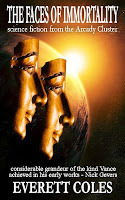 Meet Gyle Meredon, a freelance police investigator whose young daughter is abducted. Meredon must trace his daughter across the Cluster- the human settled worlds - and beyond, to the worlds Outside; rough, unfinished worlds. Whom can he trust? Who knows what happened to his daughter or why? Which world does the mysterious KZ come from and who is selling Immortality?p { margin: 0px; } .tab { text-indent:20px } First off, let's be clear—I am a sci-fi geek and as such, I can be a most demanding reader. Unless a story is particularly well told I find myself being distracted by the feasibility of things, questioning the plot and finding possible fault with the physical structure of alien races etc. I am thus doubly happy to report that Mr Coles was not only able to take me to some particularly alien worlds, portraying events and people in a very believable way, but his plot was flawless and kept me enthralled from beginning to end.
Meet Gyle Meredon, a freelance police investigator whose young daughter is abducted. Meredon must trace his daughter across the Cluster- the human settled worlds - and beyond, to the worlds Outside; rough, unfinished worlds. Whom can he trust? Who knows what happened to his daughter or why? Which world does the mysterious KZ come from and who is selling Immortality?p { margin: 0px; } .tab { text-indent:20px } First off, let's be clear—I am a sci-fi geek and as such, I can be a most demanding reader. Unless a story is particularly well told I find myself being distracted by the feasibility of things, questioning the plot and finding possible fault with the physical structure of alien races etc. I am thus doubly happy to report that Mr Coles was not only able to take me to some particularly alien worlds, portraying events and people in a very believable way, but his plot was flawless and kept me enthralled from beginning to end.As to the physical presentation of the book, Mr Coles uses good grammar and punctuation throughout adding to a most pleasurable eBook reading experience (although a greater emphasis for section breaks wouldn't go amiss). The sequel to this book, To Rule the Universe, will definitely be going on my 'To Read' list.
Available as an
eBook from Amazon.
Published on September 21, 2012 11:23
August 22, 2012
MAKING A BOOK TRAILER: Part Three
ADDING VIDEO CLIPS TO YOUR TRAILER
Okay, so by now you've looked at more video clips than the man in the Processing Department at Kodak. Now let's do some more fun stuff!
To get your video into Movie Maker, open the application and then click on the big, red plus sign Ì in the top corner of the screen.
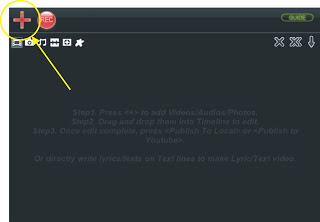
Click ADD VIDEO and then hunt down the clip you have chosen. Movie Maker then adds it to the MATERIALS box ready to use. To add a clip to the STREAM, drag it from the MATERIALS window into the STREAM window and drop it onto the VIDEO line.

Thus...
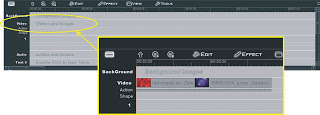
You'll note that you get a static preview pops up in the PREVIEW window in the top right hand pane and, on the far right of the STREAM area, you will see a PREVIEW THE MOVIE button...
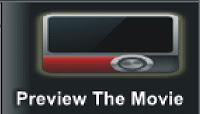
Click it and the clip will play.
Drag the same video clip from the STREAM onto the VIDEO line again and you will have your first loop. When you press the PREVIEW BUTTON now, it will play it twice and you can repeat this process as many times as you need in order to get the length of playback you want. You can also drag the end of the last clip back to make it play for a shorter length of time if needs be (it doesn't change the speed at which it plays though).
You could add different video clips to change the background as the trailer plays through, but let's keep it simple for now and just have the same video playing a number of times and move on.
ADDING TEXT TO YOUR TRAILER
If you remember, some time ago, I introduced you to the STREAM window...

.... and I pointed out the scroll bar on the right hand side. You may need to use this now to find the TEXT lines near the bottom. You have a number of these so that you can apply different text boxes in different styles etc.
As indicated on the TEXT LINE, double click on it and a new box pops up so you can enter some text. When you have finished and close the window. The text displays in the static PREVIEW window where you can click on it and drag it into the middle of the screen.
Now, an important word about timings. Do you also recall when I mentioned the 'ruler bar' at the top of the STREAM window related to time. Well, where you place the text box will tell you when the text will display and for how long.
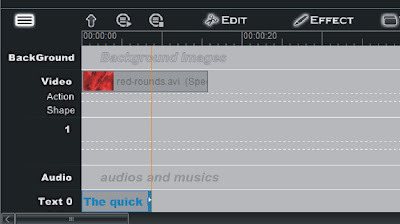
In the example above, the video clip will play from 00 seconds in the trailer to 15 seconds while the text will display from 00 seconds to 8 seconds. By moving the text block around on the line will dictate when it will appear and disappear.
It gets better too. Right click on the text block and a large menu pops up with lots of goodies. Select ADD ACTION. Now you can change the way the text appears and disappears in the two boxes provided and if you click AUTOFILL ITEM DURATION, it sorts out the timings for you too, or you can set the timings in the timings boxes for start and finish. Play with it. It's great fun and whenever you want to go back to the settings, right-click on the text block and select ACTION.
There are lots of other options on that menu too, all well worth exploring.
CONGRATULATIONS!!!
You now have the basic tools to do all the graphics for your trailer because the same techniques apply for static backgrounds, images, text, video etc. The only thing I haven't shared with you is...
THE SOUNDTRACK
This, you add in exactly the same way as everything else. You just need to know where to source those soundtracks from and just like the video clips, there are lots of sources out there, paid and free. Here are a couple of starters for you that I have found (these are not recommendations, just places I have just found and thus I accept no liability for their content).
http://freemusicforvideos.com/
http://www.videoblocks.com/videos/production-music/
http://www.freestockmusic.com/ Well, that's about it really. Good luck with all of that and let me know how you get on. It's lots of fun but it does gobble time!

Okay, so by now you've looked at more video clips than the man in the Processing Department at Kodak. Now let's do some more fun stuff!
To get your video into Movie Maker, open the application and then click on the big, red plus sign Ì in the top corner of the screen.

Click ADD VIDEO and then hunt down the clip you have chosen. Movie Maker then adds it to the MATERIALS box ready to use. To add a clip to the STREAM, drag it from the MATERIALS window into the STREAM window and drop it onto the VIDEO line.

Thus...

You'll note that you get a static preview pops up in the PREVIEW window in the top right hand pane and, on the far right of the STREAM area, you will see a PREVIEW THE MOVIE button...

Click it and the clip will play.
Drag the same video clip from the STREAM onto the VIDEO line again and you will have your first loop. When you press the PREVIEW BUTTON now, it will play it twice and you can repeat this process as many times as you need in order to get the length of playback you want. You can also drag the end of the last clip back to make it play for a shorter length of time if needs be (it doesn't change the speed at which it plays though).
You could add different video clips to change the background as the trailer plays through, but let's keep it simple for now and just have the same video playing a number of times and move on.
ADDING TEXT TO YOUR TRAILER
If you remember, some time ago, I introduced you to the STREAM window...

.... and I pointed out the scroll bar on the right hand side. You may need to use this now to find the TEXT lines near the bottom. You have a number of these so that you can apply different text boxes in different styles etc.
As indicated on the TEXT LINE, double click on it and a new box pops up so you can enter some text. When you have finished and close the window. The text displays in the static PREVIEW window where you can click on it and drag it into the middle of the screen.
Now, an important word about timings. Do you also recall when I mentioned the 'ruler bar' at the top of the STREAM window related to time. Well, where you place the text box will tell you when the text will display and for how long.

In the example above, the video clip will play from 00 seconds in the trailer to 15 seconds while the text will display from 00 seconds to 8 seconds. By moving the text block around on the line will dictate when it will appear and disappear.
It gets better too. Right click on the text block and a large menu pops up with lots of goodies. Select ADD ACTION. Now you can change the way the text appears and disappears in the two boxes provided and if you click AUTOFILL ITEM DURATION, it sorts out the timings for you too, or you can set the timings in the timings boxes for start and finish. Play with it. It's great fun and whenever you want to go back to the settings, right-click on the text block and select ACTION.
There are lots of other options on that menu too, all well worth exploring.
CONGRATULATIONS!!!
You now have the basic tools to do all the graphics for your trailer because the same techniques apply for static backgrounds, images, text, video etc. The only thing I haven't shared with you is...
THE SOUNDTRACK
This, you add in exactly the same way as everything else. You just need to know where to source those soundtracks from and just like the video clips, there are lots of sources out there, paid and free. Here are a couple of starters for you that I have found (these are not recommendations, just places I have just found and thus I accept no liability for their content).
http://freemusicforvideos.com/
http://www.videoblocks.com/videos/production-music/
http://www.freestockmusic.com/ Well, that's about it really. Good luck with all of that and let me know how you get on. It's lots of fun but it does gobble time!
Published on August 22, 2012 12:46
August 21, 2012
MAKING A BOOK TRAILER: Part Two
Right. So know we have a rough idea of what we would like to produce. Don't worry if it's a bit sketchy, just a rough outline in your head will do. Now we need some software to do it with.
It's also easy to use and you don't have to have a Starfleet Degree in Computer Engineering to get started or to download it from http://www.makeyoutubevideo.com/ . As with all of these things though, keep your eyes open for the check boxes. Everything you download these days is packed with foistware—stuff you might not want, like Google Chrome, somebody else's search bar, a new home page—but all can be avoided if you pay attention to the check boxes and supervise the installation through (don't just go for the Express Install).
So you've downloaded your Movie Maker. When you double-click on the desktop icon, you have three options. You want the one of the far left: MAKE VIDEOS. The program will then load and that's when you have kittens. It looks complicated, but it's dead easy!
The whole screen looks like this...
 But let's look at the three bits individually...
But let's look at the three bits individually...
 MATERIALSThe top right is the MATERIALS box where all your materials will be shown that you can drag down into the clip. It's a bit like a tool box full of screws and nails or a sewing box full of buttons and thread etc—stuff that you will need to make the finished product.
MATERIALSThe top right is the MATERIALS box where all your materials will be shown that you can drag down into the clip. It's a bit like a tool box full of screws and nails or a sewing box full of buttons and thread etc—stuff that you will need to make the finished product.
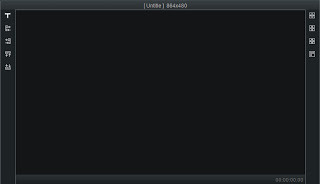 PREVIEWThe top right is the PREVIEW box which gives you a quick glimpse of whatever item you have selected.
PREVIEWThe top right is the PREVIEW box which gives you a quick glimpse of whatever item you have selected.
 STREAMThe bottom is the STREAM area where you add your video, soundtracks, music, text etc and overlay them. If you note, near the top of this window is a ruler type device. This is in fact a time line which starts at 00:00:00 being hours, minutes, seconds. You'll be able to see about 1 minute 40 seconds on your normal screen and in the free edition of MovieMaker, you can make anything up to 5 minutes long which is more than enough for a book trailer.
STREAMThe bottom is the STREAM area where you add your video, soundtracks, music, text etc and overlay them. If you note, near the top of this window is a ruler type device. This is in fact a time line which starts at 00:00:00 being hours, minutes, seconds. You'll be able to see about 1 minute 40 seconds on your normal screen and in the free edition of MovieMaker, you can make anything up to 5 minutes long which is more than enough for a book trailer.
Each of the lines below that is a different line of data: video, audio, text and you have a scroll bar on the right hand side to scroll down the different lines because you can have multiple lines of data of the same ilk. For example, on the closing shot of my video, the text about the book with ISBN numbers is one line of text and the credit in the bottom right hand corner is another line of text. Don't worry about that now though. I'll tell you more about that later. For now you can shut down Movie Maker as we need to source out video content.
VIDEO If you want to make your own video with a camcorder, you can, but that requires a bit too much kit (which I haven't got) and expertise for my liking. Also, bearing in mind that my book is sci-fi and that I don't own a space shuttle, it would be rather hard to film something suitable so I searched for looping video backgrounds. These are backgrounds that run for say 10 seconds but the start point and end point are visually identical. This means that if you play it over and over again, it's one seamless video.
Now I warn you, selecting your video is going to take hours. There are thousands out there, some of which you pay for and some are free. You also need to be aware that images come in a range of flavours, price and rights wise...
Royalty Free
This is when you pay for an image for unlimited use. Generally, you can use it for as long as you like, in as many different projects as you like.
Rights ManagedYou pay for the images and have exclusivity on it. No one else can have it but it can be very expensive.
Copyright FreeThese are completely free of charge although you often have to mention the source of the image on whatever you place it on.
Take note as well, that you will pay more for higher resolution images or longer clips, so bear that in mind. As to resolution, I can't fully advise you here (not being an expert) but mine was 640 x 480 so I'd suggest that or higher.
So, now for the goodies. Let me give you some places to browse. Naturally there are a lot more places to buy images than free ones, but here are some starters for ten:
Pay for video clips
http://footage.shutterstock.com/http://www.gettyimages.co.ukhttp://www.videoblocks.com/Freebies
http://www.motionbackgroundsforfree.com/http://dreamscene.org When you've found the one you want, if it's one you pay for, you can generally download one with a watermark on it for nothing. This means you can prepare your video with that background and see if you like it before you put your hand in your pocket. (Note though, that the watermarked ones are usually medium or higher resolution images not the cheaper, lower resolution ones.) Whichever way, once you've made your mind up and are ready to download it, do yourself a favour and make a directory on your local drive (C:\) called BOOKTRAILER or something similar and save it there. I found it really useful to have all of my material in one place on my hard drive.
Well, I'm going to leaving you scouring the internet for your backgrounds until tomorrow night when we'll start loading up the video and creating the actual footage. See you then!

It's also easy to use and you don't have to have a Starfleet Degree in Computer Engineering to get started or to download it from http://www.makeyoutubevideo.com/ . As with all of these things though, keep your eyes open for the check boxes. Everything you download these days is packed with foistware—stuff you might not want, like Google Chrome, somebody else's search bar, a new home page—but all can be avoided if you pay attention to the check boxes and supervise the installation through (don't just go for the Express Install).
So you've downloaded your Movie Maker. When you double-click on the desktop icon, you have three options. You want the one of the far left: MAKE VIDEOS. The program will then load and that's when you have kittens. It looks complicated, but it's dead easy!
The whole screen looks like this...
 But let's look at the three bits individually...
But let's look at the three bits individually...
 MATERIALSThe top right is the MATERIALS box where all your materials will be shown that you can drag down into the clip. It's a bit like a tool box full of screws and nails or a sewing box full of buttons and thread etc—stuff that you will need to make the finished product.
MATERIALSThe top right is the MATERIALS box where all your materials will be shown that you can drag down into the clip. It's a bit like a tool box full of screws and nails or a sewing box full of buttons and thread etc—stuff that you will need to make the finished product.
 PREVIEWThe top right is the PREVIEW box which gives you a quick glimpse of whatever item you have selected.
PREVIEWThe top right is the PREVIEW box which gives you a quick glimpse of whatever item you have selected. STREAMThe bottom is the STREAM area where you add your video, soundtracks, music, text etc and overlay them. If you note, near the top of this window is a ruler type device. This is in fact a time line which starts at 00:00:00 being hours, minutes, seconds. You'll be able to see about 1 minute 40 seconds on your normal screen and in the free edition of MovieMaker, you can make anything up to 5 minutes long which is more than enough for a book trailer.
STREAMThe bottom is the STREAM area where you add your video, soundtracks, music, text etc and overlay them. If you note, near the top of this window is a ruler type device. This is in fact a time line which starts at 00:00:00 being hours, minutes, seconds. You'll be able to see about 1 minute 40 seconds on your normal screen and in the free edition of MovieMaker, you can make anything up to 5 minutes long which is more than enough for a book trailer.Each of the lines below that is a different line of data: video, audio, text and you have a scroll bar on the right hand side to scroll down the different lines because you can have multiple lines of data of the same ilk. For example, on the closing shot of my video, the text about the book with ISBN numbers is one line of text and the credit in the bottom right hand corner is another line of text. Don't worry about that now though. I'll tell you more about that later. For now you can shut down Movie Maker as we need to source out video content.
VIDEO If you want to make your own video with a camcorder, you can, but that requires a bit too much kit (which I haven't got) and expertise for my liking. Also, bearing in mind that my book is sci-fi and that I don't own a space shuttle, it would be rather hard to film something suitable so I searched for looping video backgrounds. These are backgrounds that run for say 10 seconds but the start point and end point are visually identical. This means that if you play it over and over again, it's one seamless video.
Now I warn you, selecting your video is going to take hours. There are thousands out there, some of which you pay for and some are free. You also need to be aware that images come in a range of flavours, price and rights wise...
Royalty Free
This is when you pay for an image for unlimited use. Generally, you can use it for as long as you like, in as many different projects as you like.
Rights ManagedYou pay for the images and have exclusivity on it. No one else can have it but it can be very expensive.
Copyright FreeThese are completely free of charge although you often have to mention the source of the image on whatever you place it on.
Take note as well, that you will pay more for higher resolution images or longer clips, so bear that in mind. As to resolution, I can't fully advise you here (not being an expert) but mine was 640 x 480 so I'd suggest that or higher.
So, now for the goodies. Let me give you some places to browse. Naturally there are a lot more places to buy images than free ones, but here are some starters for ten:
Pay for video clips
http://footage.shutterstock.com/http://www.gettyimages.co.ukhttp://www.videoblocks.com/Freebies
http://www.motionbackgroundsforfree.com/http://dreamscene.org When you've found the one you want, if it's one you pay for, you can generally download one with a watermark on it for nothing. This means you can prepare your video with that background and see if you like it before you put your hand in your pocket. (Note though, that the watermarked ones are usually medium or higher resolution images not the cheaper, lower resolution ones.) Whichever way, once you've made your mind up and are ready to download it, do yourself a favour and make a directory on your local drive (C:\) called BOOKTRAILER or something similar and save it there. I found it really useful to have all of my material in one place on my hard drive.
Well, I'm going to leaving you scouring the internet for your backgrounds until tomorrow night when we'll start loading up the video and creating the actual footage. See you then!
Published on August 21, 2012 15:01
How to speed up your RETWEETS!
 Twitter, bless their little cotton socks, seem to be doing their best to make retweeting as difficult as possible on anything that isn't in your own Feed. Gone are the days when you could just click the RETWEET button.
Twitter, bless their little cotton socks, seem to be doing their best to make retweeting as difficult as possible on anything that isn't in your own Feed. Gone are the days when you could just click the RETWEET button.Now, if you see something you want to retweet on someone else's Feed, you have to select VIEW SUMMARY and then RETWEET. By this time, you are in a fresh window so, after you are done, you have to press the BACK button to get back to where you where but not at the same point on the page. It's all a bit annoying.
However you can get around this for regular RETWEETS. When you have found a really great Tweet of theirs, FAVOURITE it. Then, when you want to Retweet it, from your list of FAVOURITES, click (and this is where it gets silly) UNTWEET and then TWEET. This appears to work quite nicely and that's the best I can come up with at the moment. If anybody else has any further suggestions, please let me know.
Published on August 21, 2012 00:37
August 20, 2012
MAKING A BOOK TRAILER: Part One
I recently mentioned on FaceBook that I had made my first Book Trailer and asked if some friends would mind having a look at it and giving me their opinion. The response was very encouraging and a number of people asked me how I did it. Originally, I thought I could sum it up in just a couple of paragraphs, but then I realised that maybe I could be a little more generous and give everyone a guided tour on how to make a simple but effective book trailer based upon my experience.
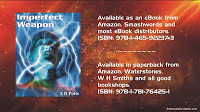 Now I'm not an expert on these things, which is a distinct advantage for the reader. Anything I say on the subject must be easily do-able. If it wasn't, then I wouldn't have done it. Time is precious to me so if I can't get good results without lots of hassle and pain, then I'm not interested.
Now I'm not an expert on these things, which is a distinct advantage for the reader. Anything I say on the subject must be easily do-able. If it wasn't, then I wouldn't have done it. Time is precious to me so if I can't get good results without lots of hassle and pain, then I'm not interested.
My biggest concern though, was going to be the cost element of it. I make a bit of pocket money out of my writing but certainly not enough to live on so I was looking for something that fitted into the right bracket—Bill Bryson summed it up beautifully 'cheap but demanding'.
So down to business.... First off, you need to have some idea of what you want to say in your book trailer, the message you want to get across. I started with a visit to YouTube and searched for 'book trailers'. Pick a good selection to have a look at and include genres in which you don't write, and if you have a peek at mine while you're there, it would make me very happy—
http://www.youtube.com/watch?v=TAWXPib5u7UYou'll soon realise that they vary enormously but take note of the things you really like and the things you don't. To my mind, the keys to a good book trailer are:
NOT TOO LONG:With a book, you have to hook the reader in with a single paragraph or two on the back. Keep the same thing in mind. We're not here to make an epic film, just a trailer. When making mine, I kept reminding myself that I needed to leave something for Steven Spielberg to work with when he finally does read my book!VISUAL IMPACT:Remember though, that if you have words appearing that you want people to read, rather than a voiceover, you don't want the visuals to draw the eye away from the text. It should support it.AUDIO IMPACT:A well-selected piece of music is always a winner.It's then worth having a sit down and jotting down a few notes about what you want to say and how you want to say it. One of the biggest things to decide is, do you want a voiceover or, as I did, text.
Now have a quick think about the type of background you are after and the type of music to accompany it—the 'feelings' that you want to invoke in the audience.
Having done all that, you should have thought about all of the following:
video, be it background or foregroundmusictext (and you'll need at least a little bit)pictures of your book coverany other graphics you wish to include
Don't worry if it's a bit sketchy, just a rough outline in your head will do.
All of that will take you a little while to think through, It's too easy to rush these things and, as with all things in life, a little bit of preparation means you will reap the bountiful reward of a good finished product, so I'm going to leave it there for today and return tomorrow with PART TWO when I'll be introducing the movie software and video imagery along with some step-by-step instructions.

 Now I'm not an expert on these things, which is a distinct advantage for the reader. Anything I say on the subject must be easily do-able. If it wasn't, then I wouldn't have done it. Time is precious to me so if I can't get good results without lots of hassle and pain, then I'm not interested.
Now I'm not an expert on these things, which is a distinct advantage for the reader. Anything I say on the subject must be easily do-able. If it wasn't, then I wouldn't have done it. Time is precious to me so if I can't get good results without lots of hassle and pain, then I'm not interested.My biggest concern though, was going to be the cost element of it. I make a bit of pocket money out of my writing but certainly not enough to live on so I was looking for something that fitted into the right bracket—Bill Bryson summed it up beautifully 'cheap but demanding'.
So down to business.... First off, you need to have some idea of what you want to say in your book trailer, the message you want to get across. I started with a visit to YouTube and searched for 'book trailers'. Pick a good selection to have a look at and include genres in which you don't write, and if you have a peek at mine while you're there, it would make me very happy—
http://www.youtube.com/watch?v=TAWXPib5u7UYou'll soon realise that they vary enormously but take note of the things you really like and the things you don't. To my mind, the keys to a good book trailer are:
NOT TOO LONG:With a book, you have to hook the reader in with a single paragraph or two on the back. Keep the same thing in mind. We're not here to make an epic film, just a trailer. When making mine, I kept reminding myself that I needed to leave something for Steven Spielberg to work with when he finally does read my book!VISUAL IMPACT:Remember though, that if you have words appearing that you want people to read, rather than a voiceover, you don't want the visuals to draw the eye away from the text. It should support it.AUDIO IMPACT:A well-selected piece of music is always a winner.It's then worth having a sit down and jotting down a few notes about what you want to say and how you want to say it. One of the biggest things to decide is, do you want a voiceover or, as I did, text.
Now have a quick think about the type of background you are after and the type of music to accompany it—the 'feelings' that you want to invoke in the audience.
Having done all that, you should have thought about all of the following:
video, be it background or foregroundmusictext (and you'll need at least a little bit)pictures of your book coverany other graphics you wish to include
Don't worry if it's a bit sketchy, just a rough outline in your head will do.
All of that will take you a little while to think through, It's too easy to rush these things and, as with all things in life, a little bit of preparation means you will reap the bountiful reward of a good finished product, so I'm going to leave it there for today and return tomorrow with PART TWO when I'll be introducing the movie software and video imagery along with some step-by-step instructions.
Published on August 20, 2012 12:11
August 16, 2012
THE EMERALD CANCER: David Hulme
p { margin: 0px; }
.tab { text-indent:20px }
When Siobhan Corrigan's beloved father is murdered by Protestant para-military forces in Northern Ireland, her father's right-hand man takes her alter ego, Sandra, and installs her with an English family to live the life of an English rose. Her role: to become a sleeper in the Terrorist Surveillance Unit run by one Michael Forsythe and report back
.tab { text-indent:20px }
When Siobhan Corrigan's beloved father is murdered by Protestant para-military forces in Northern Ireland, her father's right-hand man takes her alter ego, Sandra, and installs her with an English family to live the life of an English rose. Her role: to become a sleeper in the Terrorist Surveillance Unit run by one Michael Forsythe and report back
Published on August 16, 2012 11:17
BOOK REVIEW: The Emerald Cancer: David Hulme
p { margin: 0px; } .tab { text-indent:20px }
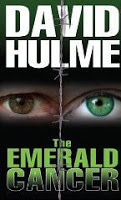 When Siobhan Corrigan's beloved father is murdered by Protestant para-military forces in Northern Ireland, her father's right-hand man takes her alter ego, Sandra, and installs her with an English family to live the life of an English rose. Her role: to become a sleeper in the Terrorist Surveillance Unit run by one Michael Forsythe and report back to Drago, the head of the Northern wing of the IRA.
When Siobhan Corrigan's beloved father is murdered by Protestant para-military forces in Northern Ireland, her father's right-hand man takes her alter ego, Sandra, and installs her with an English family to live the life of an English rose. Her role: to become a sleeper in the Terrorist Surveillance Unit run by one Michael Forsythe and report back to Drago, the head of the Northern wing of the IRA.
After the Harrods bombing in central London and a terrible personal tragedy, Patrick Rutherford also sets out on a path of revenge; his recruitment to TSU, the only conclusion. When the infiltration of TSU becomes apparent to Forsythe, he engineers a risky plan using the outsourced asset, Patrick Rutherford, to infiltrate the Northern Wing of the IRA.
Patrick Rutherford and Siobhan Corrigan were created by circumstances beyond their control, manipulated by British Intelligence and the Northern wing of the IRA. Twisted and full of hate, they are brother and sister on opposite sides of the fence. Under certain circumstances each might kill the other but in most situations the invisible thread that binds them would prevent it. When they eventually meet, the chemistry between the two of them is explosive with devastating, inexplicable consequences.
This is an exceptional book. The characters are superbly built and we are taken inside their minds with a skill that is second to none. Dramatic scenes are vividly portrayed and pull the reader's imagination skilfully into action. The author successfully transports us from one character's world into another, telling us of their beginnings with an expertise and ease that is overwhelmingly wonderful. This is truly a first class story written by a man who can most certainly tell a tale but—and I hate to say it but I must, seeing as it is something I bleat on about—it needs the final 'polish'.
This first release is tarnished by a light dusting of grammatical and formatting errors that could so easily have been addressed before its release. Normally, I'd not tolerate it so for a book to survive that flaw and for me to finish it... well, it must be good. Indeed, the book survives solely due to Mr Hulme's superb writing and storytelling skills and thus I pray for a sequel whilst also hoping that Mr Hulme will release a second edition of this novel with these flaws addressed. With that little bit of extra polish, this book could sit with pride, nestled among the offerings from any of the bestselling authors. Yes, it really is that good.
Available as an eBook from Amazon.
 When Siobhan Corrigan's beloved father is murdered by Protestant para-military forces in Northern Ireland, her father's right-hand man takes her alter ego, Sandra, and installs her with an English family to live the life of an English rose. Her role: to become a sleeper in the Terrorist Surveillance Unit run by one Michael Forsythe and report back to Drago, the head of the Northern wing of the IRA.
When Siobhan Corrigan's beloved father is murdered by Protestant para-military forces in Northern Ireland, her father's right-hand man takes her alter ego, Sandra, and installs her with an English family to live the life of an English rose. Her role: to become a sleeper in the Terrorist Surveillance Unit run by one Michael Forsythe and report back to Drago, the head of the Northern wing of the IRA.After the Harrods bombing in central London and a terrible personal tragedy, Patrick Rutherford also sets out on a path of revenge; his recruitment to TSU, the only conclusion. When the infiltration of TSU becomes apparent to Forsythe, he engineers a risky plan using the outsourced asset, Patrick Rutherford, to infiltrate the Northern Wing of the IRA.
Patrick Rutherford and Siobhan Corrigan were created by circumstances beyond their control, manipulated by British Intelligence and the Northern wing of the IRA. Twisted and full of hate, they are brother and sister on opposite sides of the fence. Under certain circumstances each might kill the other but in most situations the invisible thread that binds them would prevent it. When they eventually meet, the chemistry between the two of them is explosive with devastating, inexplicable consequences.
This is an exceptional book. The characters are superbly built and we are taken inside their minds with a skill that is second to none. Dramatic scenes are vividly portrayed and pull the reader's imagination skilfully into action. The author successfully transports us from one character's world into another, telling us of their beginnings with an expertise and ease that is overwhelmingly wonderful. This is truly a first class story written by a man who can most certainly tell a tale but—and I hate to say it but I must, seeing as it is something I bleat on about—it needs the final 'polish'.
This first release is tarnished by a light dusting of grammatical and formatting errors that could so easily have been addressed before its release. Normally, I'd not tolerate it so for a book to survive that flaw and for me to finish it... well, it must be good. Indeed, the book survives solely due to Mr Hulme's superb writing and storytelling skills and thus I pray for a sequel whilst also hoping that Mr Hulme will release a second edition of this novel with these flaws addressed. With that little bit of extra polish, this book could sit with pride, nestled among the offerings from any of the bestselling authors. Yes, it really is that good.
Available as an eBook from Amazon.
Published on August 16, 2012 11:17
August 15, 2012
BOOK REVIEW: Fae Eye for the Golem Guy: Robert C. Roman
 THE SPIEL:
THE SPIEL:Micah Slate has lived centuries, his lonely existence dedicated to the protection of art. Then he meets Ophilia Morgan, a young artist who has transformed herself into a living work of art. Micah thinks she'll never give him a second glance, but she has dark secrets of her own. When a greedy socialite uses Micah's museum as the setting for fraud and destruction, he and Ophilia will be thrown together in a night of mayhem.
p { margin: 0px; } .tab { text-indent:20px } If you are looking for a short but delightful read, this is it. It fits neatly into the genre of FANTASY with an air of Terry Pratchett about it. It's well written, grammatically correct with good punctuation and formatting--things that so often let the Indie Author down. The storyline is well-crafted, beautifully told and entertaining and the characters well rounded.
The book did something few do--I found myself wanting to go to bed so I could read the next chapter.Don't let the fact it's a short story put you off either. It's not hurried and yet it is eventful. It left me with that rare feeling of sadness that one gets when you have finished a really good book. I want more!
eBook only, available from Amazon
Published on August 15, 2012 09:52



